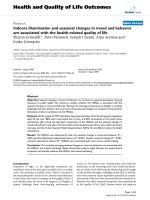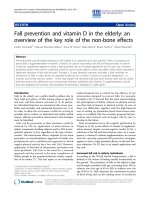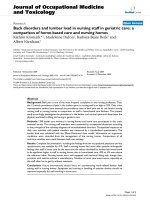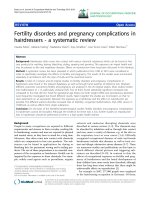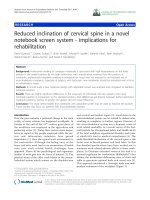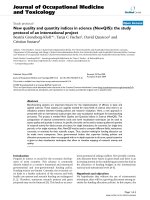Báo cáo hóa học: " Electronic States and Light Absorption in a Cylindrical Quantum Dot Having Thin Falciform Cross Section" pptx
Bạn đang xem bản rút gọn của tài liệu. Xem và tải ngay bản đầy đủ của tài liệu tại đây (326.34 KB, 8 trang )
NANO EXPRESS
Electronic States and Light Absorption in a Cylindrical Quantum
Dot Having Thin Falciform Cross Section
Karen G. Dvoyan Æ David B. Hayrapetyan Æ
Eduard M. Kazaryan Æ Ani A. Tshantshapanyan
Received: 3 September 2008 / Accepted: 11 November 2008 / Published online: 6 December 2008
Ó to the authors 2008
Abstract Energy level structure and direct light absorption
in a cylindrical quantum dot (CQD), having thin falciform
cross section, are studied within the framework of the adia-
batic approximation. An analytical expression for the energy
spectrum of the particle is obtained. For the one-dimensional
‘‘fast’’ subsystem, an oscillatory dependence of the wave
function amplitude on the cross section parameters is
revealed. For treatment of the ‘‘slow’’ subsystem, parabolic
and modified Po
¨
schl-Teller effective potentials are used. It is
shown that the low-energy levels of the spectrum are equi-
distant. In the strong quantization regime, the absorption
coefficient and edge frequencies are calculated. Selection
rules for the corresponding quantum transitions are obtained.
Keywords Modified Po
¨
schl-Teller potential Cylindrical
quantum dot Falciform cross section Light absorption
Selection rules
Introduction
Optical experiments with self-assembled quantum dots
(QDs) have demonstrated strong carrier confinement. This
is due to the fact that the dot size reduction results in strong
‘‘blue shift’’ of extremely narrow luminescence peaks of
isolated dots [1–3]. Confinement effects in magneto-
capacitance and infrared absorption have also been
observed experimentally [4, 5].
Physical properties of so-called ‘‘quantum lenses,’’ or
lenticular QDs are of special interest [4, 6, 7]. In particular,
energy spectrum of charge carriers (CCs) inside QDs
shaped as a spherical segment or an ellipsoid is studied. In
reference [8], a cylindrical quantum lens with almost semi-
circle cross section was considered. Up to date, however,
cylindrical quantum dots (CQDs) with thin lenticular cross
sections were studied in paper [9] only.
Typically, a lens geometry is assumed [10], with a cir-
cular cross section of maximum radius r, and maximum
thickness h, wherein the CCs are confined in a hard wall
potential. Mathematical description of energy levels of
such nanostructures is a delicate problem, particularly in
the thin lens limit, h=r ! 0; which corresponds to a sin-
gular perturbation regime.
Study of CQDs having thin falciform cross section will
enable one to model more realistic structures which are
usually formed in the course of manufacturing. Generally,
during growth of QDs, due to unavoidable diffusion process
of interface atoms, a coating interlayer between the CQD
material and semiconductor matrix is formed. This new
interlayer, CDQ with thin falciform cross section, affects
the distribution of quantum levels of the CQD significantly.
In this paper, we study electronic states and direct light
absorption in CDQs having thin falciform cross section. For
the lower energy levels of the CQD, the confining potential is
approximated by one-dimensional potential with variable
width.
Theory
Thus, we consider an impenetrable CQD having thin fal-
ciform cross section, as shown in Fig. 1a. Potential energy
K. G. Dvoyan D. B. Hayrapetyan E. M. Kazaryan
A. A. Tshantshapanyan (&)
Department of Applied Physics and Engineering,
Russian-Armenian State University, 123 Hovsep Emin Str.,
Yerevan 0051, Armenia
e-mail:
D. B. Hayrapetyan
Department of Physics, State Engineering University
of Armenia, 105 Terian Str., Yerevan 0009, Armenia
123
Nanoscale Res Lett (2009) 4:130–137
DOI 10.1007/s11671-008-9212-7
of a charged particle (an electron, or a hole) has the fol-
lowing form:
Uðx; y; zÞ¼
0; x
2
þðy þy
1
Þ
2
R
2
1
\ x
2
þðy þy
2
Þ
2
R
2
2
;
z 2c; c½;
1; in the other areas
8
>
>
<
>
>
:
; ð1Þ
where R
1
¼ðR
2
0
þ L
2
1
Þ=2L
1
, R
2
¼ðR
2
0
þ L
2
2
Þ=2L
2
are radii
of two circles of the cross section, respectively, 2c is height
of the cylinder, L
1
, L
2
are heights of cross section seg-
ments, respectively, R
0
is the intersection point of the
circles and X-axes. The motion of the charged particle in
the plane of cross section is localized in the dashed area as
it is shown in Fig. 1b.
In the strong size quantization (SQ) regime, the elec-
tron-hole Coulomb interaction energy is much less than the
confinement energy of the CQD walls. In this regime, one
can neglect the Coulomb interaction. Thus, the energy
states of the electron and the hole should be determined
independently. The particular shape of CQD suggests that
motion of a CC in the Y-direction should be faster than that
in X-direction what enables one to apply adiabatic
approximation. The Hamiltonian of the system in this case
has the following form:
^
H ¼
"h
2
2l
o
2
oX
2
þ
o
2
oY
2
þ
o
2
oZ
2
þ UðX; Y; ZÞ: ð2Þ
Being expressed through dimensionless variables, the
Hamiltonian (2) may be represented as the sum of the
‘‘fast’’ and ‘‘slow’’ subsystems’ operators,
^
H
1
and
^
H
2
;
respectively, and, the Z-direction
^
H
3
operator:
^
H ¼
^
H
1
þ
^
H
2
þ
^
H
3
þ Uðx; y; zÞ; ð3Þ
where
^
H
1
¼
o
2
o y
2
;
^
H
2
¼
o
2
o x
2
;
^
H
3
¼
o
2
o z
2
; ð4Þ
and the following notations are introduced: x ¼ X=a
B
; y ¼
Y=a
B
; z ¼ Z=a
B
;
^
H ¼
^
H= E
R
; with E
R
¼ "h
2
=2m
e
a
2
B
being
the effective Rydberg energy, a
B
¼ j"h
2
=m
e
e
2
; the effective
Bohr radius of electron, m
e
, the effective mass of electron,
and j, the dielectric constant of the medium. We seek the
wave function of the problem in the following form:
Wðx; y; zÞ¼uðxÞf ðy; xÞvðzÞ: ð5Þ
Due to the CQD problem symmetry, motion of the
electron in the z-direction is separated. The energy is given
by the following expression:
e
z
¼
p
2
n
2
z
4c
2
; n
z
¼ 1; 2; ; ð6Þ
where n
z
is the quantum number.
When the coordinate of the ‘‘slow’’ subsystem, x,is
fixed, the motion of the electron is localized in the one-
dimensional effective potential well, having the following
spatial profile:
hðxÞ¼h
2
ðxÞh
1
ðxÞ; ð7Þ
h
1
ðxÞ¼
ffiffiffiffiffiffiffiffiffiffiffiffiffiffiffiffiffiffiffiffiffiffiffiffiffiffiffiffiffiffiffiffi
R
2
0
þ L
2
1
2
4L
2
1
x
2
s
þ L
1
R
2
0
þ L
2
1
2L
1
;
h
2
ðxÞ¼
ffiffiffiffiffiffiffiffiffiffiffiffiffiffiffiffiffiffiffiffiffiffiffiffiffiffiffiffiffiffiffiffi
R
2
0
þ L
2
2
2
4L
2
2
x
2
s
þ L
2
R
2
0
þ L
2
2
2L
2
;
ð8Þ
where L L
2
L
1
is the maximal value of CQD falciform
cross section height.
The Schro
¨
dinger equation for the ‘‘fast’’ subsystem has
the form
f ðy; xÞ
00
þ f ðy; xÞe
1
ðxÞ¼0: ð9Þ
After simple transformations, one can obtain the
following expressions for the wave function and electron
energy, respectively:
f ðy;xÞ
¼
ffiffiffiffiffiffiffiffiffiffiffiffiffiffiffiffiffiffiffiffiffiffiffiffiffiffi
2
h
2
ðxÞh
1
ðxÞ
s
cos
pnh
1
ðxÞ
h
1
ðxÞh
2
ðxÞ
sin
pn
h
1
ðxÞh
2
ðxÞ
y
þ
ffiffiffiffiffiffiffiffiffiffiffiffiffiffiffiffiffiffiffiffiffiffiffiffiffiffi
2
h
2
ðxÞh
1
ðxÞ
s
sin
pnh
1
ðxÞ
h
1
ðxÞh
2
ðxÞ
cos
pn
h
1
ðxÞh
2
ðxÞ
y;
ð10Þ
Fig. 1 a Cylindrical quantum
dot with thin falciform cross
section. b Cross section of
cylindrical quantum dot
Nanoscale Res Lett (2009) 4:130–137 131
123
e
1
ðxÞ¼V
Real
¼
p
2
n
2
h
2
ðxÞ
; n ¼ 1; 2; ; ð11Þ
where n is the quantum number.
Here we obtain the following result: the wave functions’
amplitudes depend on geometrical parameters of the QD
shape. This means that probability of the CC localization
presents oscillatory behavior near the peripheral areas of
CQD.
Expression (11) takes the place of the potential in the
Schro
¨
dinger equation for the ‘‘slow’’ subsystem, but the
Schro
¨
dinger equation with such effective potential is not
analytically solvable. That is why we have applied adia-
batic approximation, to solve this problem. Two models for
the ‘‘slow’’ subsystem effective potentials are used.
Parabolic Approximation
The ‘‘slow’’ subsystem potential energy is formed by fal-
ciform geometry of the QD cross section which allows to
use adiabatic approximation. Namely, we use the condition
x
jj
R
0
which means that CC is localized in the vicinity
of the geometric center of falciform cross section. This
condition holds for the low-energy states. For the higher
excited energy states, the adiabatic approximation is not
applicable. The energy of the ‘‘fast’’ subsystem is repre-
sented by the Taylor series, where linear, cubic, and other
odd terms are equal to zero:
e
1
ðxÞ¼V
Par
ðxÞa
n
þ b
2
n
x
2
ð12Þ
with
a
n
¼
p
2
n
2
L
2
; b
2
n
¼
p
2
n
2
ðR
1
R
2
Þ
R
1
R
2
L
3
: ð13Þ
Condition L R
0
clearly indicates that the fourth-order
term is about 100 times smaller than the quadratic term.
Here it should be noted that the origin of the quadratic
potential is due to the fact that the width of one-
dimensional effective potential well is a variable quantity.
Expression (12) plays the role of the effective potential
in the Schro
¨
dinger equation for the ‘‘slow’’ subsystem:
u
00
ðxÞþ e a
n
b
2
n
x
2
uðxÞ¼0: ð14Þ
Solving this equation, we obtain the expressions for the
CC wave function and energy:
uðxÞ¼e
b
n
x
2
2
H
N
ffiffiffiffiffi
b
n
p
x
; ð15Þ
e ¼ a
n
þ 2b
n
N þ
1
2
; N ¼ 0; 1; 2; ð16Þ
where H
N
ffiffiffiffiffi
b
n
p
x
are Hermit polynomials, and N is
oscillatory quantum number.
Modified Po
¨
schl-Teller Potential Approximation
As it was mentioned above, the adiabatic approximation is
applicable for calculation of lower levels of the energy
spectrum. Parabolic potential, obtained by use of Taylor
series of the energy expression for the ‘‘fast’’ subsystem,
gives rise to a set of equidistant energy levels in spectrum. It
is notable that each energy level of the ‘‘fast’’ subsystem has
its own set of equidistant levels with gaps depending on the
quantum number of the particular ‘‘fast’’ subsystem. How-
ever, only two or three lower energy levels are split into
equidistant level subsystems; for higher levels of the ‘‘fast’’
subsystem the sublevels are not equidistant any more.
We suggest a more realistic model of one-dimensional
effective potential which we represent in the form of
modified Po
¨
schl-Teller potential (see Fig. 2)[11, 12]. In
dimensionless quantities, this potential has the following
form:
e
1
ðxÞ¼V
PT
ðxÞ¼
p
2
n
2
L
2
kðk 1Þ
c
2
chðx=cÞðÞ
2
þ
kðk 1Þ
c
2
: ð17Þ
Here k and c are parameters describing the depth and width
of corresponding quantum well, respectively. Note that
they depend on the quantum number n of the ‘‘fast’’ sub-
system. Choice of this particular potential is explained by
the fact that the Taylor expansion of potential (17) for
small values of the x-coordinate is parabolic as it is the case
for (12) also. On the other hand, at higher values of the
x-coordinate the discrepancy of the Po
¨
schl-Teller potential
from parabolic one is increasing. Thus, violation of equi-
distance of energy levels of ‘‘slow’’ subsystem can be taken
into account.
The one-dimensional Schro
¨
dinger equation with the
Po
¨
schl-Teller potential reads:
Fig. 2 Dependence of one-dimensional effective potentials on coor-
dinate x
132 Nanoscale Res Lett (2009) 4:130–137
123
u
00
ðxÞþ e
p
2
n
2
ðL
2
L
1
Þ
2
kðk1Þ
c
2
þ
kðk1Þ
c
2
chðx=cÞðÞ
2
!
uðxÞ¼0:
ð18Þ
We adopt the following notation:
k
2
¼ e
p
2
n
2
L
2
kðk 1Þ
c
2
ð19Þ
thus reducing Eq. 18 to the following one [12]:
u
00
þ k
2
þ
kðk 1Þ
c
2
ch x=cðÞðÞ
2
!
u ¼ 0: ð20Þ
A series of transformations results in the following
expressions for the wave function and energy spectrum of
CC:
uðxÞ¼ch
k
x
c
"
C
1
2
F
1
u; v;
1
2
; 1 ch
2
x
c
þC
2
1 ch
2
x
c
1
2
2
F
1
u þ
1
2
; v þ
1
2
;
3
2
; 1 ch
2
x
c
#
;
ð21Þ
e ¼
ðk 1 nÞ
2
c
2
þ
p
2
n
2
L
2
þ
kðk 1Þ
c
2
; ð22Þ
where u ¼
1
2
ðk ckÞ and v ¼
1
2
ðk þckÞ; C
1
and C
2
are
normalization constants,
2
F
1
a; b; c; xðÞis the
hypergeometric function. For small values of the
coordinate x, the potential (17) takes the form
V
PT
ðxÞ
p
2
n
2
L
2
þ
kðk 1Þx
2
c
4
: ð23Þ
Further, solution to the Schro
¨
dinger equation for the
‘‘slow’’ subsystem with the potential (23) is completely
similar to the procedure with parabolic potential considered
above. As a result, we arrive at the following expression for
the equidistant energy spectrum of a CC:
e ¼ a
n
þ
2
ffiffiffiffiffiffiffiffiffiffiffiffiffiffiffiffiffi
kðk 1Þ
p
c
2
N þ
1
2
; N ¼ 0; 1; 2; ð24Þ
which perfectly agrees with the result (16).
Direct Interband Light Absorption
Now, we consider direct interband light absorption by
CQD with thin falciform cross section, in the strong SQ
regime. This means that the conditions L a
e
B
; a
h
B
are
satisfied, where a
eðhÞ
B
is an effective Bohr radius of the
electron (or the hole). We consider the case of a heavy
hole, when m
e
m
h
; with m
e
and m
h
being the effective
masses of the electron and hole, respectively. Under con-
ditions of one-electron band theory approximation, the
absorption coefficient is given by the expression [13]:
K ¼ A
X
m;m
0
Z
W
e
m
W
h
m
0
dr
~
2
d "hX E
g
E
e
m
E
h
m
0
; ð25Þ
where m and m
0
are sets of quantum numbers corresponding
to the electron and heavy hole, E
g
is the forbidden gap
width in the bulk semiconductor, X is the incident light
frequency, and A is a quantity proportional to the square of
matrix element in decomposition over Bloch functions.
We have performed numerical simulations for a QD
consisting of GaAs with the following parameters: m
e
¼
0:067m
0
; m
e
¼ 0; 12m
h
; E
R
¼ 5:275 meV; a
e
B
¼ 104
˚
A;
E
g
¼ 1:43 eV; m
0
is a free electron mass. Finally, for the
parabolic case for the quantity K and, absorption edge (AE)
we obtain, respectively,
K ¼ A
X
n;N;N
0
I
n;N;N
0
d "hX E
g
E
e
m
E
h
m
0
ð26Þ
W
110
¼ 1 þ
p
2
4
d
2
c
2
þ p
2
d
2
L
2
þ 2p
ffiffiffiffiffiffiffiffiffiffiffiffiffiffiffiffi
R
2
R
1
R
1
R
2
r
d
2
ffiffiffiffiffi
L
3
p
ð27Þ
where W
110
¼ "hX
110
=E
g
; I
n;N;N
0
is an integral quantity (see
Appendix 1). Here we use expression d ¼ "h=
ffiffiffiffiffiffiffiffiffiffi
2lE
g
p
as a
length unit, where l ¼ m
e
m
h
=m
e
þ m
h
is the reduced mass
of the electron and hole.
Selection rules in the case of the parabolic potential appear
to be as follows: n
z
¼ n
0
z
: For other quantum numbers tran-
sitions between the corresponding levels are admissible. Note
that in the limit case when L
1
! 0 the falciform cross section
becomes a segment of a circle and we arrive at the following
well-known result: the transitions are allowed between the
energy levels having quantum numbers in z-direction n
z
¼ n
0
z
;
in y-direction, n ¼ n
0
and, different parity (see [8]). In the
oscillatory quantum number values, transitions are allowed
between the levels either having N ¼ N
0
and equal parity
quantum numbers, N N
0
¼ 2t: Partial reduction of number
of selection rules in the case of falciform cross section of
cylindrical-well QD is due to oscillatory character of the
dependence of wave function’s amplitude (10) on cross sec-
tion parameters of the QD. Obviously, that transition to the
limit L
1
! 0 is equivalent to the limit h
1
ðxÞ!0inexpres-
sion (10). Thus, the oscillatory character of dependence of the
wave function amplitude [see (10)] on cross section parame-
ters of QD is canceled. In other words, the electron and hole
wave functions’ overlap integral in the falciform cross section
plane is always nonzero, a fact which partially reduces the
selection rules’ number.
It is worth mentioning that in the case of cylindrical QD
with circular cross section considered in the paper [14], the
Nanoscale Res Lett (2009) 4:130–137 133
123
transitions are allowed between the energy levels with
quantum numbers m ¼m
0
; n
z
¼ n
0
z
; where m is magnet-
ical quantum number in the plane of cross section.
In the case of modified Po
¨
schl-Teller potential, for the
quantity K and AE we obtain
K ¼ A
X
n;N;N
0
J
n;N;N
0
d "hX E
g
E
e
m
E
h
m
0
ð28Þ
W
110
¼
p
2
4
d
2
c
2
þ p
2
d
2
L
2
þðk 2Þ
2
d
2
c
2
þ kðk 1Þ
d
2
c
2
ð29Þ
where W
100
¼ "hX
100
=E
g
; J
n;N;N
0
is an integral quantity (see
Appendix 1). In this case the same selection rules for
quantum numbers are valid, as in the case of parabolic
approximation.
Discussion of Results
As one can see from the CC energy spectrum expressions
(16) and (24), the energy levels inside the CQD with fal-
ciform cross section are equidistant. More precisely, each
level of the ‘‘fast’’ subsystem has its own family of equi-
distant energy levels created by the ‘‘slow’’ subsystem. As
a consequence of the adiabatic approximation, this result is
valid only for the low spectrum levels (i.e., small quantum
numbers). Note that the CC levels are equidistant in the
case when h
1
ðxÞ!0 also [9]. However, in the case when
h
1
ðxÞ 6¼ 0; the wave function amplitude dependence on
falciform cross section parameters is unique [see (10)]. As
it is mentioned above, this dependence results in oscillatory
behavior of the wave function amplitude thus affecting the
overlap integral form and partially reduces the selection
rules set. It is also important that approximation of one-
dimensional energy expression by a modified Po
¨
schl-Teller
potential enables one to take into account the energy levels
which are nonequidistance at higher energy values. One
can see from Fig. 2 that the effective one-dimensional
potential is well approximated by the modified Po
¨
schl-
Teller potential. As the x-coordinate grows, the discrep-
ancy between the exact and approximate potentials
becomes evident both for the modified Po
¨
schl-Teller and
parabolic potentials (see Appendix 2).
Figure 3 illustrates the dependence of the CC spectral
energy levels for the first equidistant family inside CQD
having falciform cross section as a function of height L
1
of
the small cross section segment, in both cases of one-
dimensional potential approximation. In other words, we
compare results obtained from relations (16) with those
from (24). From Fig. 3, it is easily seen that the CC energy
levels are equidistant in both cases since for small values of
the x-coordinate it is sufficient to keep only quadratic terms
in the Taylor development of the modified Po
¨
schl-Teller
potential what leads to practical coincidence with parabolic
potential. Growth of the parameter L
1
results in width
reduction of falciform cross section of the CQD, which in
its turn increases the CC energy due to SQ. However, when
decomposition of modified Po
¨
schl-Teller potential is used,
the energy levels are positioned higher than in parabolic
potential approximation and their gap is increased with L
1
.
This fact is explained by higher SQ portion in the particle
energy. One can see from Fig. 2, with increasing of x-
coordinate approximated modified Po
¨
schl-Teller potential
increases faster than parabolic potential. Thus the effect of
QD walls is stronger in the first case than in the second.
Figure 4 illustrates the dependence of first three energy
levels of a CC on the height L
1
of the small segment in the
falciform cross section, when the modified Po
¨
schl-Teller
potential approximation is used. Note that the energy levels
are not more equidistant (see expression 22). As it was
mentioned above, the modified Po
¨
schl-Teller potential
allows describing nonparabolic character of the CC energy,
the fact clearly shown in Fig. 4. Such dependence (both in
‘‘fast’’ and ‘‘slow’’ motions) opens a sufficiently broad
opportunity for using the CQD ensemble as an active
medium in quantum lasers. For example, in US Patent
#6541788 a method and device for converting light from a
first wavelength to a second wavelength is presented,
where acting objects are multilayer ellipsoidal quantum
dots and lenses; it is a good example for targeting appli-
cations this research.
Figure 5 shows dependence of light absorption fre-
quency edges for the CQD on the height L
1
of the small
segment of falciform cross section under fixed values of
large segment height L
2
, when parabolic approximation is
Fig. 3 Dependence of first equidistant family of CC energy in CQD
with thin falciform cross section on height of segment L
1
for both
parabolic and Po
¨
schl-Teller cases
134 Nanoscale Res Lett (2009) 4:130–137
123
used. Note that L
1
growth causes the AE shift to higher
frequencies (‘‘blue’’ shift). Thus, the contribution of SQ
becomes higher as falciform width is reduced. For the same
reason the curves corresponding to small L
2
values are
positioned higher. Opposite behavior is seen in Fig. 6,
where AE dependence on the large segment height L
2
under fixed values of small segment height L
1
is shown for
the case when parabolic approximation is used. As
expected, larger L
2
values cause the shift of AE to low
frequencies (‘‘red’’ shift). This phenomenon is explained
by reduced SQ effect of QD walls when width of the
falciform cross section becomes larger. The curves
corresponding to small values of parameter L
1
are posi-
tioned below, which is also explained by reduction of
confinement effect.
Finally, in Figs. 7 and 8 comparisons are given of the
AE values or the falciform cross section with parameters L
1
and L
2
in the cases when parabolic and modified Po
¨
schl-
Teller potential approximations are used. One can see in
the Fig. 7 that the curves converge when L
1
is small (broad
cross section). As the height L
1
is increased, the AE, as it
has already been mentioned, shifts to higher frequencies
and the difference between the AE values observed more
distinctly due to higher contribution of SQ. And vice versa,
Fig. 4 Dependence of first three levels of CC energy in CQD with
thin falciform cross section on height of segment L
1
for Po
¨
schl-Teller
potential realization case
Fig. 5 Dependence of AE in CQD with thin falciform cross section
on height of segment L
1
for parabolic potential realization case for
fixed values of L
2
Fig. 6 Dependence of AE in CQD with thin falciform cross section
on height of segment L
2
for parabolic potential realization case for
fixed values of L
1
Fig. 7 Dependences of AE in CQD with thin falciform cross section
on height of segment L
1
for fixed values of L
2
for both parabolic and
Po
¨
schl-Teller cases
Nanoscale Res Lett (2009) 4:130–137 135
123
similar interpretation can be given to Fig. 8 where the AE
shifts to low frequencies and curves converge as the
parameter L
2
is increased.
Conclusion
Thus, we have theoretically proved that energy spectrum of
a CC inside CQD having falciform cross section is equi-
distant for the lower spectrum levels. Meanwhile, the
energy dependence on geometric parameters of QD has the
root character. We have revealed the unique (oscillatory)
character of the wave function amplitude dependence on
geometric parameters of CQD cross section. The formed
one-dimensional effective motion potential has been suc-
cessfully modeled by modified Po
¨
schl-Teller potential,
which makes possible an account of the real potential
divergence from the parabolic potential. The effect of the
former potential which we developed in Taylor series for
the lower energy levels of CC (provided that the particle is
localized in the cross section center of CQD) has been
compared in the paper with the effect of purely parabolic
potential. Direct interband light absorption by CQD having
falciform cross section has been analyzed. The oscillatory
dependence of the effective one-dimensional motion wave
function amplitudes on geometric parameters of the cross
section has shown lead to partial reduction of selection
rules in light absorption process.
Cylindrical quantum lenses and especially falciform
CQDs, as a more realistic nanostructures with account of
nonparabolicity of forming potential, have various com-
mercial applications. For example, they are widely used in
large two-dimensional focal plane arrays in the mid- and
far infrared (M&FIR) region. They also have important
applications at pollution detection, thermal imaging object
location and remote sensing as well as infrared imaging of
astronomical objects.
Mentioned optimized quantum structures can be formed
by direct epitaxial deposition using a self-assembling QDs
technique, described, e.g., in the US Patent #6541788
entitled as ‘‘Mid infrared and near infrared light upcon-
verter using self-assembled quantum dots’’ as well as by
usage of MBE, MOCVD, or MOMBE deposition systems.
Results of presented theoretical investigation can be
directly applied to the photonics field as background for
simulation model. One of the hot topics of this field is
developing a scheme for optimization of growth of CQD
needed for second harmonic generation.
Acknowledgments This research has been undertaken with finan-
cial support of ANSEF grant PS-nano #1301 and Armenian State
Target Program ‘‘Semiconductor Nanoelectronics.’’
Fig. 8 Dependences of AE in CQD with thin falciform cross section
on height of segment L
2
for fixed values of L
1
for both parabolic and
Po
¨
schl-Teller cases
Appendix 1
I
n;N;N
0
¼
Z
1
0
h
2
ðxÞþh
1
ðxÞ
h
1
ðxÞh
2
ðxÞðÞ
2pn
sin
h
2
ðxÞþh
1
ðxÞ
h
1
ðxÞh
2
ðxÞ
2pn
h
2
ðxÞh
1
ðxÞ
exp
1
2
ffiffiffiffiffiffiffiffiffiffiffiffiffiffiffiffiffiffiffiffiffiffiffiffiffiffiffiffiffiffiffiffiffiffiffiffiffiffiffiffiffi
p
2
n
2
R
2
0
þL
2
1
2L
1
R
2
0
þL
2
2
2L
2
R
2
0
þL
2
1
2L
1
R
2
0
þL
2
2
2L
2
L
2
L
1
ðÞ
3
v
u
u
u
t
x
2
8
>
<
>
:
9
>
=
>
;
H
N
ffiffiffiffiffiffiffiffiffiffiffiffiffiffiffiffiffiffiffiffiffiffiffiffiffiffiffiffiffiffiffiffiffiffiffiffiffiffiffiffiffi
p
2
n
2
R
2
0
þL
2
1
2L
1
R
2
0
þL
2
2
2L
2
R
2
0
þL
2
1
2L
1
R
2
0
þL
2
2
2L
2
L
2
L
1
ðÞ
3
4
v
u
u
u
t
x
0
B
@
1
C
A
exp
1
2
ffiffiffiffiffiffiffiffiffiffiffiffiffiffiffiffiffiffiffiffiffiffiffiffiffiffiffiffiffiffiffiffiffiffiffiffiffiffiffiffiffi
p
2
n
2
R
2
0
þL
2
1
2L
1
R
2
0
þL
2
2
2L
2
R
2
0
þL
2
1
2L
1
R
2
0
þL
2
2
2L
2
L
2
L
1
ðÞ
3
v
u
u
u
t
x
2
8
>
<
>
:
9
>
=
>
;
H
N
0
ffiffiffiffiffiffiffiffiffiffiffiffiffiffiffiffiffiffiffiffiffiffiffiffiffiffiffiffiffiffiffiffiffiffiffiffiffiffiffiffiffi
p
2
n
2
R
2
0
þL
2
1
2L
1
R
2
0
þL
2
2
2L
2
R
2
0
þL
2
1
2L
1
R
2
0
þL
2
2
2L
2
L
2
L
1
ðÞ
3
4
v
u
u
u
t
x
0
B
@
1
C
A
dx
2
136 Nanoscale Res Lett (2009) 4:130–137
123
Appendix 2
Estimation of Relative Energy Error at Adiabatic
Approximation
Let us define relative error for one-dimensional energy as
ratio V
Real
ðxÞe
ParðPTÞ
1
ðxÞ
=V
Real
ðxÞ; where V
Real
ðxÞ is
exact calculated energy of CC in one-dimensional quantum
well, e
Par
1
ðxÞa
1
þ b
2
1
x
2
is interpolated Taylor series of
adiabatic approximated energy of CC and e
PT
1
ðxÞ¼a
1
kðk1Þ
c
2
chðx=cÞðÞ
2
þ
kðk1Þ
c
2
is the Po
¨
schl-Teller approximated energy
of CC, respectively. This estimation approach can be used as
a useful tool for designing objects for practical applications
from theoretically modeled samples. According to Fig. 9,at
utilization of the adiabatic approximation the magnitude of
the error comprises 10
-4
what demonstrates the high accu-
racy one attains at implementation of this approximation.
References
1. S. Fafard et al., Phys. Rev. B 50, 8086 (1994). doi:10.1103/
PhysRevB.50.8086
2. M. Grundmann et al., Phys. Rev. Lett. 74, 4043 (1995). doi:
10.1103/PhysRevLett.74.4043
3. S. Lee et al., Phys. Rev. B 61, R2405 (2000). doi:10.1103/
PhysRevB.61.R2405
4. A. Wojs et al., Phys. Rev. B 54, 5604 (2001). doi:10.1103/
PhysRevB.54.5604
5. A. Lorke et al., Phys. Rev. Lett. 84, 2223 (2000). doi:10.1103/
PhysRevLett.84.2223
6. L.C. Lew Yan Voon et al., J. Phys. Condens. Matter. 14, 13667
(2002). doi:10.1088/0953-8984/14/49/321
7. K. Dvoyan, in Proceedings of Semiconductor Micro- and
Nanoelectronics the Fifth National Conference Aghveran,
Armenia, September 16–18 (2005), pp. 169–172
8. C. Trallero-Herrero et al., Phys. Rev. E. Stat. Nonlin. Soft Matter
Phys. 64, 056237–056241 (2001). doi:10.1103/PhysRevE.64.
056237
9. A. Chanchapanyan, in Proceedings of the Fifth International
Conference ‘‘Semiconductor Micro- and Nanoelectronics’’
(2005), p. 189
10. D. Leonard et al., Phys. Rev. B 50, 11687 (1994). doi:10.1103/
PhysRevB.50.11687
11. P. Harrison, Quantum Wells, Wires and Dots: Theoretical and
Computational Physics (Wiley Ltd, NY, 2005)
12. S. Flu
¨
gge, Practical Quantum Mecannics (Springer, Berlin,
1971)
13. Al.L. Efros, A.L. Efros, Sov. Phys. Semicond. 16, 772 (1982)
14. H.A. Sarkisyan, Mod. Phys. Lett. 18, 443 (2004). doi:10.1142/
S0217984904007062
J
n;N;N
0
¼
Z
1
0
h
2
ðxÞþh
1
ðxÞ
h
1
ðxÞh
2
ðxÞðÞ
2pn
sin
h
2
ðxÞþh
1
ðxÞ
h
1
ðxÞh
2
ðxÞ
2pn
h
2
ðxÞh
1
ðxÞ
ch
k
x
c
C
1
2
F
1
u; v;
1
2
; 1 ch
2
x
c
þ
þC
2
1 ch
2
x
c
1
2
2
F
1
u þ
1
2
; v þ
1
2
;
3
2
; 1 ch
2
x
c
#
ch
k
x
c
C
3
2
F
1
u; v;
1
2
; 1 ch
2
x
c
þ
þC
4
1 ch
2
x
c
1
2
2
F
1
u þ
1
2
; v þ
1
2
;
3
2
; 1 ch
2
x
c
#
dx
2
Fig. 9 Estimation of relative energy error curve for both parabolic
and Po
¨
schl-Teller cases
Nanoscale Res Lett (2009) 4:130–137 137
123
